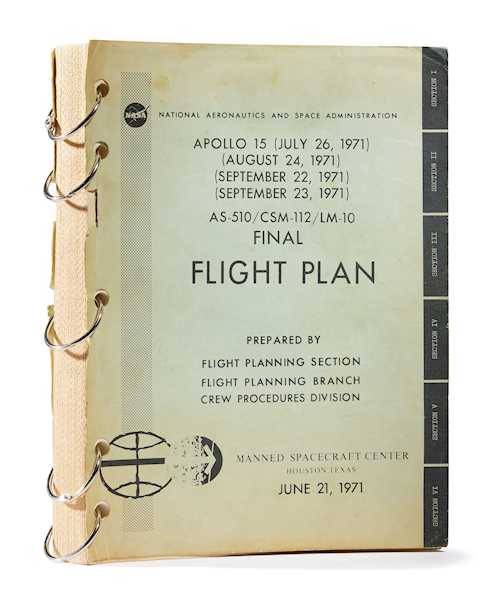
Lotto 4024* - A209 Out of This World - lunedì, 17. giugno 2024, 16h00
LOT OF TWO NASA OBJECTS
A: APOLLO 15 FLIGHT PLAN
B: APOLLO 13 CONTROL DISPLAY
Florida, USA
27 × 20.5 × 3 cm
The Apollo 15 mission was NASA's fourth manned flight to the moon, which lasted from July 26 to August 7, 1971. The three-man team consisting of Commander David R. Scott, Lunar Module Pilot James B. Irwin and Command Module Pilot Alfred M. Worden carried out three extravehicular activities. The so-called lunar roving vehicle was used for the first time, scientific experiments were carried out and 66 kg of sample material was collected.
A flight plan like the one presented here provided the crew and Mission Control with a quick overview of the planned events during the spaceflight, as well as a wealth of other information about the carefully planned exploration mission. The flight plan is ring-bound, in good condition and has handwritten notes. A great reference book for space historians and enthusiasts alike.
Copy, signed by Fred Haise
1970, Florida, USA
Lithograph
70.5 × 36.6 cm
Certificate:
– Letter of Authenticity authenticity from ’Space Authentication Zarelli ’
Apollo 13 was the seventh crewed mission in the Apollo space program and the third that was meant to land on the moon. The craft was launched from Kennedy Space Center on 11 April 1970, but the lunar landing was aborted after an oxygen tank in the service module failed two days into the mission. The crew instead looped around the moon in a circumlunar trajectory and returned safely to Earth on 17 April. The mission was commanded by Jim Lovell, with Jack Swigert as command module pilot and Fred Haise as lunar module pilot. Due to this evasive maneuvermanoeuvre, Haise and his crew hold the record for the farthest distance from the earth ever travelled by human beings.
Detailed knowledge about the engine and control devices is essential for the success of every mission, but during Apollo 13, the LM flight controls had to be used in an entirely new manner. Since an explosion took out the main oxygen tanks, they improvised and used the Lunar lunar Module module Descent descent Engineengine, the engine from the lunar lander, designed to slow the LM’s decent to the moon — to instead push the crippled Command command Module module and essential Earth re-entry capsule in an untested manner, like a rear-engine locomotive.
The lithograph presented here is a copy of the life-saving control display that flew around the moon and back on Lunar lunar Module module Aquarius. This full-sheet diagram of the Apollo 13 Lunar lunar Module module illustrates its display and control devices with over 100 switches, knobs, and meters. It is also provided with annotations in red, made by Fred Haise as well as a short text and his signature.
CHF 1 000 / 1 500 | (€ 1 030 / 1 550)
Venduto per CHF 1 250 (incl. premio dell'acquirente)
Non si assume alcuna responsabilità per la correttezza di queste informazioni.





